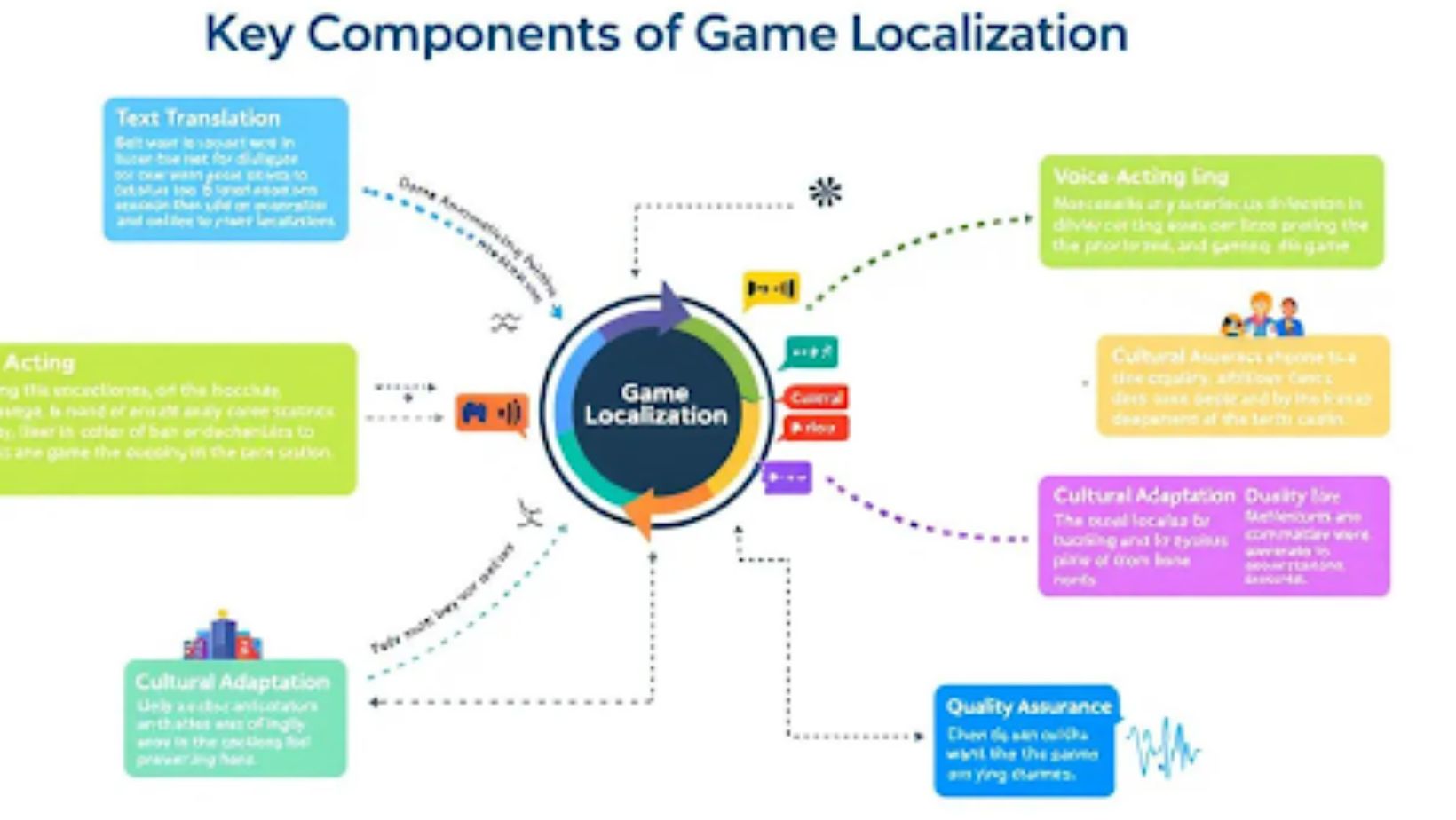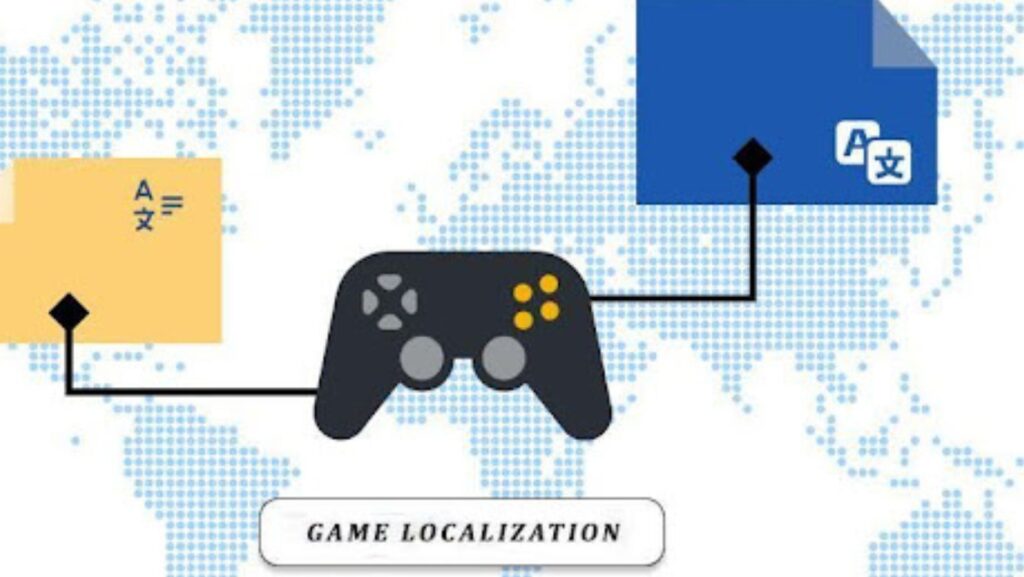Video game localisation adapts games to different languages and cultures. It goes beyond text translation, modifying cultural references and in-game elements to fit local preferences. Effective video game localisation makes a game feel native to players everywhere, improving their experience and growing global appeal.
Key Takeaways
- Effective video game localization goes beyond translation; it adapts cultural and linguist elements to create an immersive experience for players worldwide.
- Quality localization can significantly boost a game’s market reach and player engagement, resulting in greater revenue and brand loyalty.
- Starting the localization process early and utilizing advanced tools improves efficiency and ensures culturally relevant adaptations that resonate with diverse audiences.
What is Video Game Localisation?
Video game localization refers to adapting video games to the language and culture of specific regions, ensuring they are relevant and engaging for players worldwide. This process goes beyond mere translation of text; it involves cultural adjustments to make the game feel native to the target audience. Localization includes everything from changing character names to modifying cultural references, so the game resonates with local players.
Effective localization enhances player enjoyment by creating an immersive experience that aligns with their cultural expectations in a fictional world. Imagine playing a game where the humor, idioms, and cultural references are spot-on – it not only makes the game more enjoyable but also fosters a deeper connection with the narrative. This level of immersion is achieved by thoroughly adapting the game to resonate with players in different regions.
Localization must address both linguistic and cultural facets to avoid issues such as translation errors and narrative incoherence. It involves changes to text, audio, and even non-linguistic elements like date formats and user interface adjustments to ensure effectiveness in multiple languages and language localization. By doing so, game developers can create a seamless and engaging experience for players, regardless of their geographical location.
Difference Between Game Translation and Localisation
While game translation focuses solely on converting the text and dialogue from one language to another, video game localization encompasses a broader scope. Translation is about conveying the meaning of words and sentences into another language, often requiring precise and accurate text conversion to maintain the narrative. However, this is just one part of the puzzle.
Localization, on the other hand, ensures the game feels authentic and engaging by incorporating cultural adjustments, full voice-overs, and gameplay modifications. It is about adapting the entire original game to meet cultural and linguistic expectations, which may even include changing game titles to better fit the target market. This comprehensive approach ensures that the game resonates deeply with players, making it more than just a translated version of the original Japanese version.
In essence, while translation is about the words, localization is about the experience. By going beyond text, localization addresses cultural nuances, idioms, and local preferences, ensuring the game is immersive and enjoyable for players in different regions. This is why development and localization teams must work closely to create localized versions that truly capture the essence of the game.
The Importance of Video Game Localisation
In today’s globalized market, video game localization is paramount to success. Localized games can access previously untapped multiple markets, significantly boosting revenue potential for global audiences. Access to billions of additional players allows game developers to substantially increase their market share and revenue through localizing games.
Localization familiarizes and engages players, enhancing their overall experience. Culturally relevant localization ensures that players feel a deeper connection to the game, fostering higher satisfaction and loyalty. Effective localization in competitive markets can differentiate products, leading to better reviews and sustained player engagement.
Quality localization services also protect brand integrity by preventing translation errors that may offend or confuse players. Servicing cultural and linguistic needs leads to greater adoption, engagement, and revenue, making localization a crucial driver for player loyalty and market growth.
In summary, video game localization is essential for success in the thriving global video game industry, particularly for game companies and the game title, as well as for video game translation.
Key Components of Game Localisation

Effective video game localization involves several key components, each playing a crucial role in ensuring the game’s content resonates with a global audience. These components include:
- Text translation
- Audio localization
- Cultural adaptation Each element requires meticulous attention to detail to create a seamless and immersive gaming experience.
Localization includes adapting cultural references, idioms, and jokes to ensure the game feels native language to regional players. Non-linguistic adaptations, such as changing date formats and currencies, are also necessary to avoid confusion and ensure the game is user-friendly for players in different languages and different cultures. Official localization is essential in this process.
Text Translation
Text translation is a critical aspect of video game localization, requiring a thorough understanding of the game’s context to avoid errors in dialogue. Accurate text translation ensures that the game’s narrative and dialogues resonate with the target audience, maintaining player engagement and understanding.
Achieving precise translations requires translators to grasp the game’s context, ensuring translated dialogue fits within the narrative framework and feels natural to players. This level of accuracy is essential for creating an immersive and enjoyable gaming experience.
Audio Localization
Audio localization is crucial for ensuring engagement with the target audience. Recording voiceovers requires consideration of cultural sensitivities and the emotional tone relevant to the target audience. Voiceovers aligned with cultural expectations foster a deeper connection with players.
Well-localized audio significantly enhances the overall gaming experience and player satisfaction. By ensuring that voiceovers are culturally and emotionally appropriate, game developers can enhance player immersion and enjoyment.
Cultural Adaptation
Cultural adaptation is essential for effective game localization. It involves altering or censoring specific content to fit cultural norms and avoid cultural offensiveness. Some game content may need to be completely altered or removed to respect cultural taboos and sensitivities.
Understanding local preferences for character designs and game characters and cultural elements and cultural references can significantly enhance player engagement in different markets. Examples of successful cultural adaptation include changes made to the Wolfenstein series for German localization to comply with prohibitions against Nazi iconography.
Steps in the Game Localisation Process

The game localization process involves several critical steps to ensure a successful global game launch:
- Preparation and planning
- Creating a localization kit
- Translating and editing content
- Quality assurance and testing
Each step is essential for creating a localized version that resonates with the target audience in the final stage.
Following a step-by-step process ensures that all aspects of localization are thoroughly addressed, enhancing the game’s overall quality and player experience. Effective management of the localization process enables game developers to achieve a successful global launch.
Initial Planning and Strategy
Incorporating localization assets early in development streamlines the process and avoids last-minute challenges. Starting localization early enhances efficiency and minimizes the risk of delays during the game’s release.
Understanding target culture allows tailoring the localization strategy to appeal to distinct cultural preferences for target audiences. Preparing a launch plan includes outlining timelines, budgets, identifying necessary specialists for localization, and creating effective marketing materials.
Creating a Localization Kit
A localization kit is a comprehensive style guide for translators, including:
- Content
- Brand voice
- Glossary
- Localization processes
It is most useful when outsourcing localization, as it provides translators with the necessary resource files to maintain consistency and accuracy in the source language.
The kit should include a glossary of key terms, character profiles, and various files, instructions, and resources for effective translation. Character profiles help translators understand relationships and tone for dialogues, ensuring the game’s content remains coherent and engaging.
Translating and Editing Content
Professional translation requirements include:
- Translating dialogue, menus, cut scenes, manuals, and any potential voice-acting.
- Indexing dialogue strings and player-visible text in separate files from the game code for better management.
- Using native speakers to ensure cultural relevance and idiomatic accuracy in translations.
Employing CAT features in the editor helps maintain consistency of item names and terms across the game. Machine translation can expedite the translation process, but it’s crucial that human editing follows to ensure quality. Editing automatic translations is important to make them feel more natural and less like machine output.
Machine-translated content must be thoroughly edited for accuracy and cultural relevance before release. This ensures that the game’s content may require translation to be engaging and immersive for players in different regions, avoiding poor translation and keeping up with game updates, including the Japanese version and the game engine.
Quality Assurance and Testing
Quality assurance checks for linguistic accuracy and cultural fit during game localization include:
- Ensuring translations are correct.
- Making sure translations resonate culturally with the target audience. Localization vendors ensure consistency and quality by:
- Managing translation.
- Managing quality control.
The linguistic quality assurance (LQA) process identifies cosmetic and contextual bugs that can disrupt the gaming experience. Tools like Centus can simplify this process by helping identify issues in translated strings. Adequate time for the qa team ensures their effectiveness in the localization process.
After completing quality assurance, the final step is importing the checked content back into the localized versions of the game. This ensures accurate implementation of all translations, preparing the game for a successful global launch.
Tips for Optimizing Your Game Localisation Workflow
Optimizing the game localization workflow is essential for efficiency and quality. Key points to consider include:
- Automation can greatly enhance the efficiency of the localization workflow.
- Handling localization in-house may be necessary if the budget does not allow for outsourcing.
- Efficient workflows help ensure that localization efforts are timely and effective.
Streamlining processes and using advanced tools effectively manage localization efforts. By doing so, localization teams can ensure that the game’s content is accurately translated and culturally adapted for different markets.
Start Early in Development
Starting localization efforts early avoids compressed timelines and last-minute challenges. Early integration of the localization team ensures a smooth adaptation process during the localization phase. Partial localization should be integral to the development team cycle rather than an afterthought.
Localization should begin once core features are stable to enhance efficiency and minimize delays.
Utilize Advanced Localization Tools
Advanced localization tools speed up the translation process and reduce costs. Translation management systems (TMS) oversee localization processes and ensure consistency. Machine translation (MT) tools like Google Translate and DeepL facilitate quick automated translations for localization efforts.
Localization management platforms like Centus effectively manage user interfaces localization. When choosing localization manager tools, identify bottlenecks and challenges, compare market solutions, and book demos.
Collaborate with Experienced Localization Teams
Working with professionals with industry-specific knowledge significantly improves localization quality. A deep understanding of the gaming industry allows localization professionals to address both language and cultural nuances effectively.
Tools like Crowdin facilitate collaboration by enabling teams and communities to participate in localization projects, allowing real-time communication and role assignments. Advanced tools like Crowdin enhance teamwork, leading to a more efficient localization process.
Summary
In summary, video game localization is an essential aspect of reaching global audiences and ensuring the success of a game in different markets. By understanding the key components of localization, planning early, utilizing advanced tools, and collaborating with experienced teams, game developers can create engaging and immersive experiences for players worldwide.
Localization is not just about translating text; it’s about adapting the entire game to resonate with different cultures and languages. By following the tips and best practices outlined in this guide, you can optimize your localization workflow and achieve a successful global game launch.
Frequently Asked Questions
What Is The Difference Between Game Translation And Localization?
Game translation is about converting text into another language, whereas localization takes it a step further by adapting the entire game for cultural relevance and player experience. Embrace the power of localization to create a game that resonates with players worldwide!
Why Is Video Game Localization Important?
Video game localization is crucial as it opens up new markets and boosts player engagement, ultimately driving revenue growth. By tailoring the game experience to different cultures, you can connect more deeply with players around the world!
What Are The Key Components Of Game Localization?
To successfully localize a game, focus on text translation, audio localization, and cultural adaptation, as these elements are essential for providing players around the world with an engaging experience. Remember, making your game relatable and accessible will elevate its global appeal!
How Can Game Developers Manage Tight Deadlines In Localization?
Incorporating localization early in the development process is key to managing tight deadlines effectively. Ensure you allow adequate time for linguistic quality assurance to maintain quality without compromising on time.
What Tools Can Help Optimize The Game Localization Workflow?
Using advanced localization tools like Translation Management Systems (TMS), machine translation (MT) tools, and platforms like Centus will significantly streamline your game localization workflow. Embrace these technologies to enhance speed and consistency in your translations!




